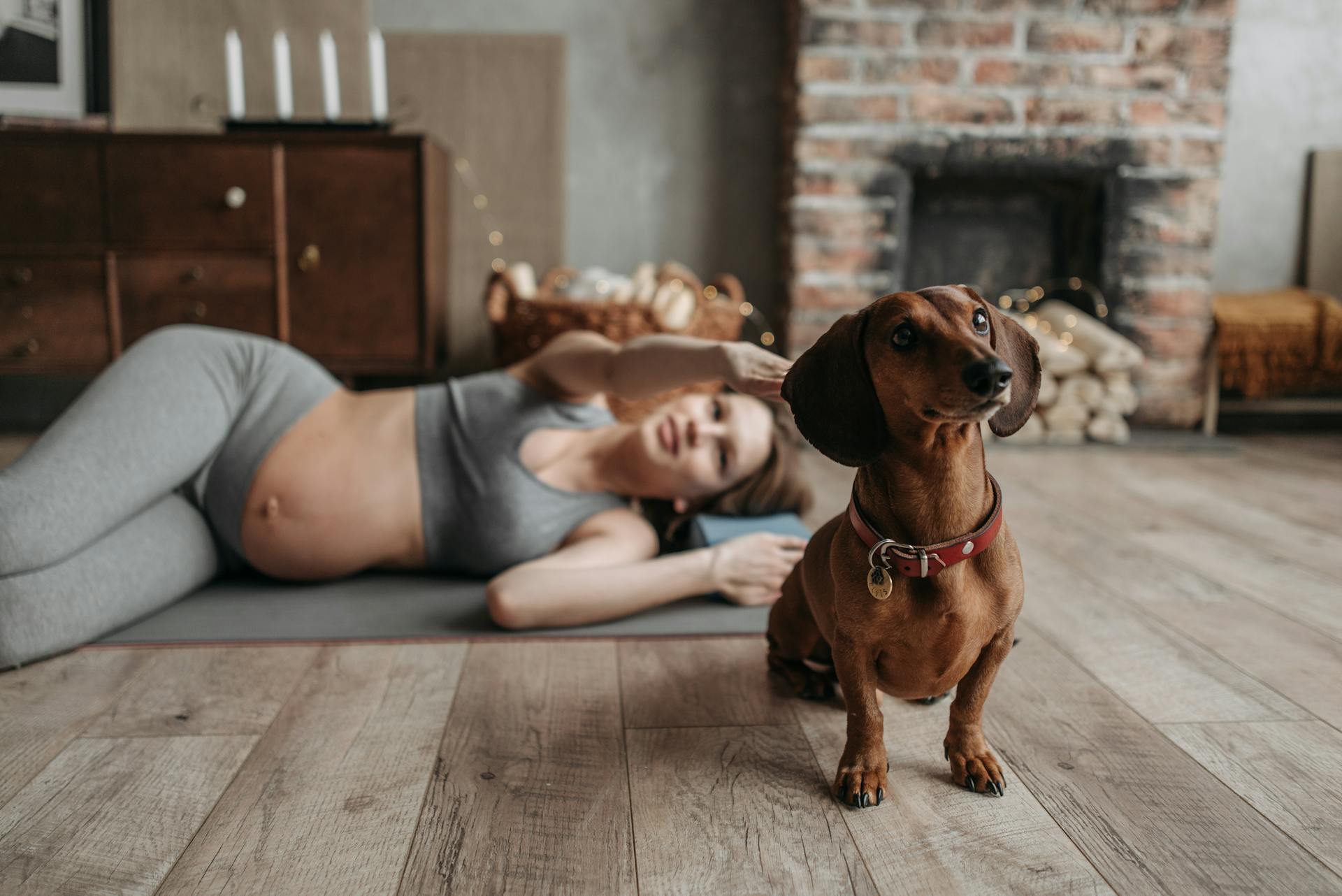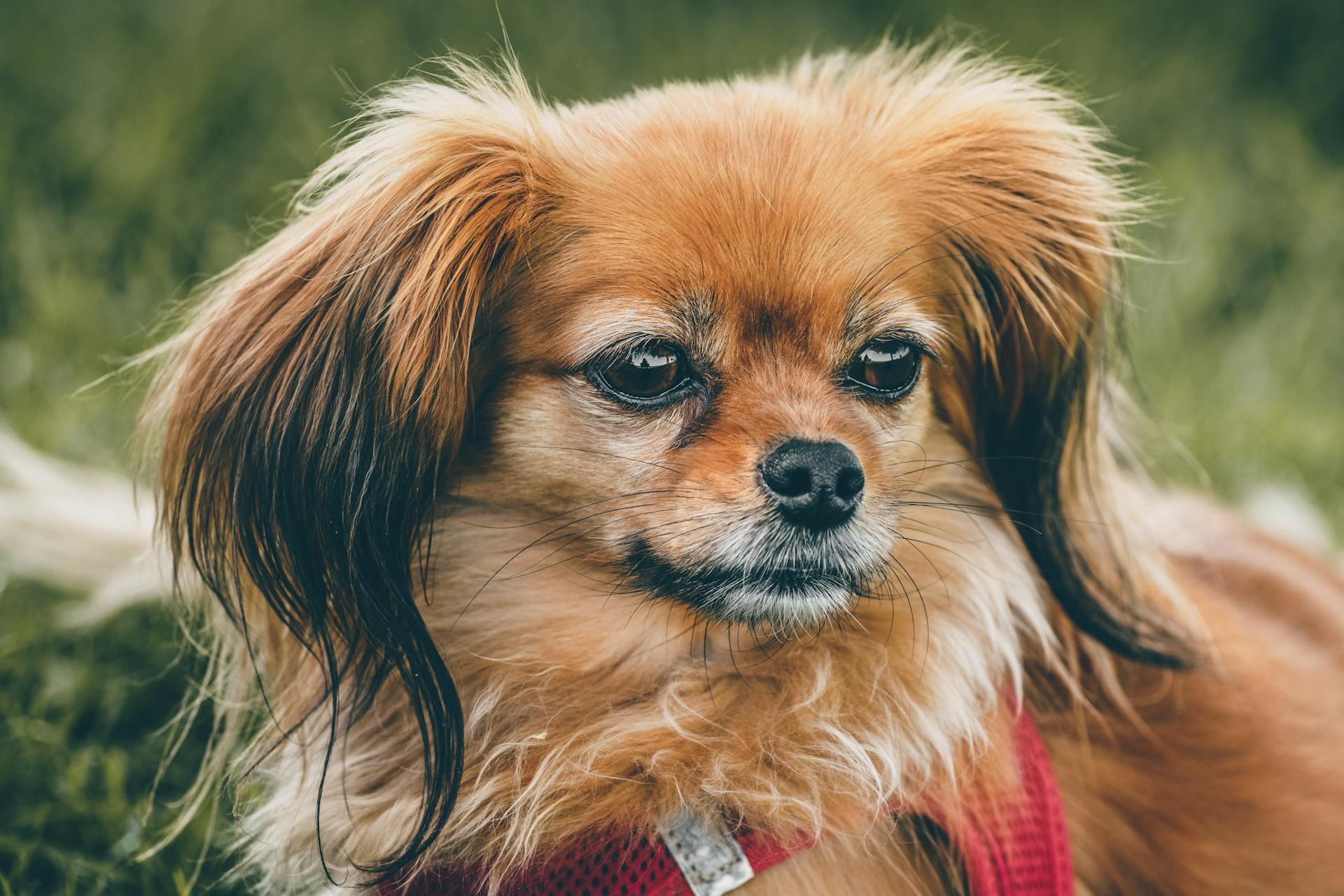
Dachshunds and Papillons are two distinct breeds, but when combined, they create a unique and loving companion known as a Papshund.
Their short stature requires careful consideration when it comes to exercise, as they can be prone to back problems.
To ensure your Papshund stays happy and healthy, provide regular, gentle exercise such as short walks and playtime in a securely fenced area.
Their small size also means they need a balanced diet to maintain a healthy weight, which can help prevent joint issues.
Ancestry and History
The Papshund's ancestry is a fascinating blend of two beloved breeds: the Dachshund and the Papillon.
Dachshunds originated in Germany in the 15th century and were bred to hunt above and below ground, making them unique in their versatility.
Papillons, on the other hand, have their roots in Spain but rose to prominence in France in the 16th century, where they became favored companions of the aristocracy.
Both breeds have a rich history, with Dachshunds being a great inspiration for artists like Picasso, and Papillons being known for their butterfly-shaped ears that caught the attention of the French court.
Their crossbreed, the Papshund, is a hybrid that tends to pick up the best traits from each parent, making them easier to train and more obedient than the Sausage Dog.
The Papillon's dropped-ear variation, the Phalene, is a rare trait that can be present in the same litter as Papillons, with its name referencing the dog's ears looking like wings at rest like a moth.
The Dachshund's name translates to "badger dog" in German, reflecting their original purpose as hunters of prey like hare, deer, and wild boar.
Today, the Papshund is recognized by five different breed associations, and while they may not be among the top 10 most expensive dog breeds, they're not cheap either.
Care and Maintenance
Papshunds are moderate shedders, requiring weekly brushings to maintain a healthy coat. Their long hair can easily get tangled, so regular brushing is a must.
You'll want to use a slicker and pin brush for detangling and preserving their coat. Brushing their teeth at least once a week is also essential for maintaining oral hygiene.
The Papshund's long hair in their large ears makes frequent checks and cleanings necessary to prevent dirt buildup and infections. Using an ear wash or wipes frequently can help keep their ears clean and healthy.
Grooming
Papshunds are moderate shedders, requiring 1-2 weekly brushings with a slicker and pin brush to detangle and maintain a healthy coat.
Their medium-length, soft hair is prone to matting and tangling if not brushed regularly. Gentle brushing twice a week can help prevent these issues.
The long hair in their large ears makes frequent checks and cleanings necessary to prevent dirt buildup and infections. Using ear wash or wipes frequently can help keep their ears clean.
Papshunds don't usually have a doggy odor, but their ears still require regular attention to prevent infections. Regular checks and cleanings can help keep their ears healthy.
A fresh viewpoint: Wire Hair Dachshund
Brushing their teeth at least once a week is essential for maintaining oral hygiene. Dental chews and chew toys can also help keep their teeth clean.
Nail trimming is necessary every few weeks to prevent overgrowth. Introducing your pet to nail trimming early on can make the process easier.
Papshunds typically don't need frequent bathing, but their coat may require a bath if it gets dirty. Using a vet-recommended ear wash or wipes can help keep their ears clean and prevent infections.
Care and Maintenance
When it comes to caring for your Papshund, feeding them the right food is crucial. Most veterinarians recommend one meal per day for Papshunds, so be sure to stick to that.
To ensure your Papshund gets the best nutrition, consider the following top-rated dry dog food brands: Wellness Core Grain-Free, Newman’s Own Organics Advanced Formula Dried Dog Food, and Blue Buffalo. These brands are a great starting point, but always consult with your vet for personalized recommendations.

Papshunds are prone to gaining weight, so it's essential to monitor their portions and treats. Stick to one standard cup per day and ration treats for special occasions.
Here are some key food-related tips to keep in mind:
Remember, every dog is different, so be prepared to adjust your approach as needed. By following these guidelines, you'll be well on your way to providing your Papshund with the care and nutrition they deserve.
Health and Conditions
Papshunds are generally a healthy breed, but like any dog, they can inherit health issues from their parents. They can live up to 16 years or more with proper care.
Skin problems and seizures are potential health concerns for Papshunds, especially due to their Dachshund parent. Regular vet visits can help minimize these risks.
Papshunds can be prone to patellar luxation, a condition where the kneecap slips out of place. This can cause pain and discomfort for your dog.
Regular eye exams are essential for Papshunds, as they can be prone to eye diseases like cataracts and glaucoma. These conditions can lead to blindness if left untreated.
A Papshund's build can make them prone to intervertebral disc disease, which can cause back problems and even paralysis. Providing ramps and baby gates can help prevent injuries.
Here's a list of potential health issues that Papshunds may be prone to:
- Patellar luxation
- Ear infections
- Cataracts
- Glaucoma
- Progressive retinal atrophy
- Obesity
- Intervertebral disc disease
- Diabetes
Training and Behavior
Training a Papshund requires patience and consistency, especially when it comes to potty training, which can be challenging due to their Dachshund heritage.
Socialization is key to reducing the risks of separation anxiety and making your Papshund happy, calm, and less prone to fear. This involves playing and mixing with other dogs, letting them meet and interact with people, and changing your walking routine occasionally.
Papshunds need daily exercise, but it's not too intense - 30-45 minutes of vigorous exercise is sufficient to tire them out. A fenced-in yard for playtime is ideal, but any time outdoors requires close supervision.
Resource guarding may be a problem, requiring training and environmental changes, but house training and obedience training are relatively straightforward with this intelligent hybrid. Positive reinforcement and rewards work best for Papshunds, who respond well to consistent training.
Here are some key training tips to keep in mind:
- Ensure your pup plays and mixes with other dogs.
- Let them meet and interact with people.
- Change your walking routine occasionally.
- Use crate training to help with housebreaking and establishing a routine.
- Be patient and consistent in your training approach.
Early socialization and training are vital for Papshunds, who can be prone to separation anxiety and require plenty of love and attention from their owners. With the right approach, however, Papshunds can thrive as loving and loyal companions.
Exercise
Papshunds are active and energetic individuals, requiring a lot of activity and exercise. They can enjoy activities throughout the day if you have a backyard.
Their exercise needs aren't extreme, but they do require 30-45 minutes of vigorous exercise daily to tire them out. This can include walks around the block or socializing them at a dog park.
Papshunds are likely to run off or escape under a poorly established fence, so close supervision is crucial when they're outside. A fenced-in yard to play fetch or chase them around is ideal.
Their small size means they're at greater risk of predation by wild animals, so it's best to keep them leashed in public. They could easily escape through a hole in the fence.
Papshunds excel at agility, and it's a great way to bond, socialize, and exercise with your pup. They're game for almost anything, and agility is an excellent outlet for their tenacious nature.
If you set up an obstacle course in the backyard, you'll unleash their natural skills and keep them entertained. Just keep the jumps low to stay easy on their back.
Suitability of Dogs for Families
Papshunds make great pets for families with kids, singles, couples, seniors, and first-time owners. They are suitable for apartment living and are easy to travel with.
They love to play and will likely follow the kids around like their shadow. This means they thrive in households with multiple family members who can engage them and provide attention.
Papshunds are affectionate and make cuddly lap dogs when their energy needs have been met. They are also gentle and playful with kids, making them a great addition to families with young children.
However, it's essential to note that their delicate bodies are a concern around young children, so supervision is necessary to ensure their safety.
A Papshund's lovability and devotion are a delight for attentive households. They are sweet, gentle, and playful with kids, and they thrive among family members with whom they can forge strong bonds.
Here are some key characteristics to consider when deciding if a Papshund is right for your family:
- Suitable for apartment living
- Easy to travel with
- Affectionate and cuddly
- Gentle and playful with kids
- Require supervision around young children
- Thrives in households with multiple family members
Ultimately, Papshunds are a great choice for families who are willing to provide the attention and care they need to thrive.
Owning a Dog
Owning a Papshund is relatively easy, as they require minimal space, material possessions, or food. They are adaptable to different living situations and can travel easily by plane or car.
Papshunds are suitable for various types of owners, including families with kids, singles, couples, seniors, and first-time owners. They make great pets for apartment living and are easy to travel with.
Here are some key things to consider when owning a Papshund:
- Provide regular socialization to reduce the risks of separation anxiety.
- Ensure your pup plays and mixes with other dogs to make them happy, calm, and less prone to fear.
- Let them meet and interact with people to teach them not to bark at strangers.
Reasons to Get a Papillon Dachshund Mix
Owning a Papillon Dachshund Mix can be a wonderful experience, and here's why:
They make great pets for families with kids, singles, couples, seniors, and first-time owners, making them a versatile choice.
These dogs are suitable for apartment living and are easy to travel with, making them perfect for city dwellers or frequent travelers.
Papshunds love to play and will likely follow the kids around like their shadow, providing endless entertainment.
They are affectionate and make cuddly lap dogs when their energy needs have been met, making them a great companion for anyone.
Here are some key characteristics of the Papillon Dachshund Mix:
They are also easily trainable and obedient, making them a great choice for first-time owners.
Reasons Not to Get a Dog
Owning a dog can be a wonderful experience, but it's essential to consider the potential challenges before bringing one home. Some dogs can be loud, especially if they lean more towards their Dachshund parent.
If you're not prepared to provide regular exercise, your dog may become anxious or obese. This is especially true for Papshunds, which can be prone to back problems as they age due to their sturdy shape.
It's crucial to consider the long-term care of your dog, as they can require additional attention as they get older. This might involve regular veterinary check-ups to monitor their back health.
Dogs become members of the family, and it would be irresponsible to let them into your life and then get rid of them if the situation proves to be too challenging.
Here are some potential issues to consider:
- Loudness
- Anxiety or obesity due to lack of exercise
- Back problems due to sturdy shape
Owning a Dog
Owning a dog can be a wonderful experience, but it's essential to understand the unique needs of your furry friend. They require attention to their individual needs to stay healthy, happy, and obedient.
Papshunds, in particular, make ownership relatively easy. They travel well by plane or car, and finding pet-friendly hotels is rarely a challenge.
You'll need to consider their needs, such as space, material possessions, and food, but these are relatively minimal. However, all dogs have unique requirements, so it's crucial to understand what they need to thrive.
One of the benefits of owning a Papshund is that they are suitable for apartment living and are easy to travel with. This makes them a great choice for city dwellers or those who enjoy exploring new places.
To ensure your Papshund stays happy and healthy, socialization is key. This means exposing them to various environments, people, and other dogs to reduce the risk of separation anxiety.
Here are some essential socialization tips:
- Play and mix with other dogs to keep them happy, calm, and less prone to fear.
- Meet and interact with people to help them learn not to bark at strangers.
- Change your walking routine occasionally to explore new places and surroundings.
Frequently Asked Questions
What is a papshund dog?
A Papshund is a hybrid dog breed that combines the characteristics of a Papillon and a Dachshund, resulting in a unique and endearing companion. This toy hybrid is known for its distinctive appearance and lively personality.
What is the personality of a Papshund?
The Papshund is a friendly, adaptable, and affectionate breed that thrives on love and attention. They're perfect for city or country living, requiring minimal exercise and a strong bond with their owners.
Featured Images: pexels.com


